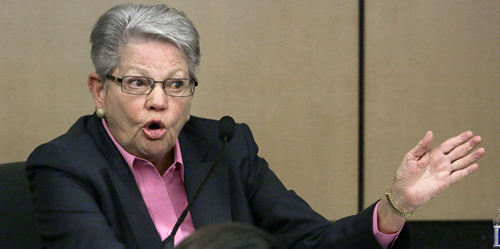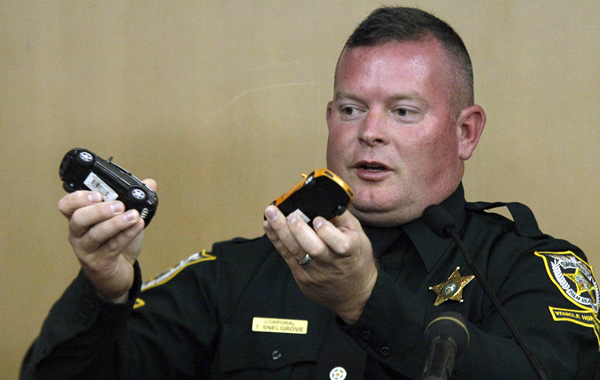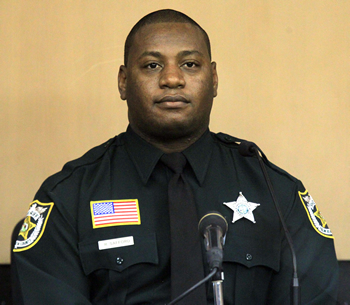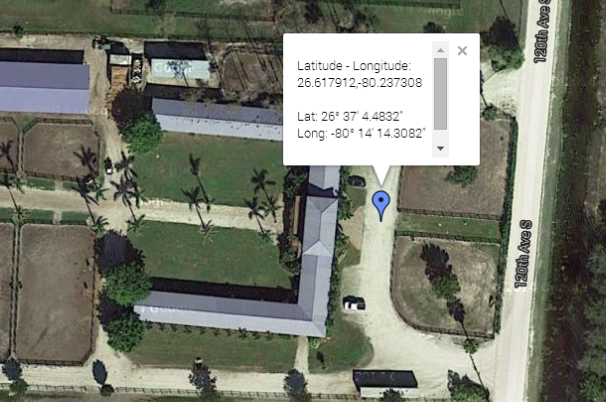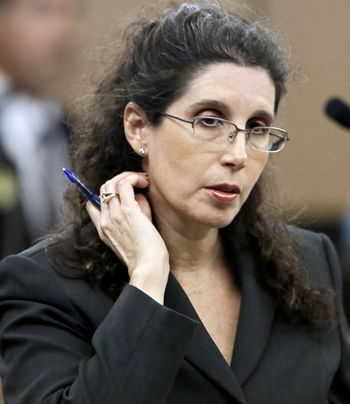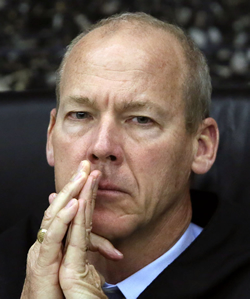
Florida's
John B. Goodman
Not Guilty?



 Share
This Article
Share
This Article
By Joseph Snook
Investigative Reporter
John Goodman © The Palm Beach Post/ZUMAWest Palm Beach, Florida - Guilt is supposed to be determined by an impartial jury of our peers. Today, however, guilt is generally assumed upon the reading of charges and state-authorized and released details in the local daily paper, national tabloids if you're “worthy” enough, and/or online on Facebook or Twitter. This poisoning of the jury pool is a delight to every prosecutor's office across the country. However, fact is often very different to the state's accounting of the details and once revealed paints a much different picture, often resulting in a truth-based perception that the charged person is not guilty or in other words, is innocent.
Now, you will finally be able to read about “Polo Mogul” John Goodman's case from a significantly unique perspective based on the evidence. This is not what the assigned West Palm Beach Prosecutors and a few deputies have reported to the mainstream media to pass on to the public. This reporting is the result of months of digging through evidence, testimony and communication with eye-witnesses and experts. More-so, when the research began, the presumption was that Goodman was guilty. What I uncovered was that there is more than enough evidence to illicit a preponderance of innocence, not guilt; and that unless the state continually lies about the facts, or the jurists have a vendetta to convict, Goodman cannot be found guilty. Quite simply, there is no definitive evidence that can be considered beyond a reasonable doubt in favor of a guilty verdict, it is quite the opposite. Remember, the burden of proof is the states, not Mr. Goodman's.
The John Goodman Case:
On February 12, 2010 John Goodman, 47, was returning home from a YMCA charity event and dinner/social function (bar) when his car suddenly collided with another vehicle driven by 23-year-old Scott Wilson. The events that followed tragically ended the life of Scott Wilson, and have left John Goodman fighting for his innocence - for the second time in almost four years. The evidence obtained in this case gives convincing details of how Sheriff's Deputies Ricardo Safford and Troy Snelgrove, along with Prosecutors Ellen Roberts (retired) and Sherri Collins allegedly committed crimes - revealing they had lied, withheld exculpatory evidence, threatened one law enforcement officer to not testify (would hurt the states’ case), willfully and negligently destroyed key evidence, obstructed justice, failed to render aid, and possibly accepted bribes.
John Goodman was originally convicted of DUI Manslaughter/Failure to Render Aid and Vehicular Homicide/Failure to Render Aid on March 23, 2012. Legal experts have stated that trial errors “warranted a new trial” and most likely would have resulted in a successful appeal, however, juror misconduct was discovered. Having kept John Goodman from receiving a review by an impartial jury, Goodman secured the right to a new trial, currently scheduled for Oct. 6, 2014. This trial is supposed to take place as if the first trial's outcome did not even exist, and Goodman is once again facing his charges which carry a reported 30-year sentence, if convicted.
The Accident
The accident occurred shortly before 1:00 am on a dark February night. There were no eye-witnesses. The road conditions were normal, and the weather was reported to be in the 50's. Visibility was an issue due to the accident’s rural location with a thumbnail moon. This made it difficult to see, which was expressed by two post-crash witnesses who called 911, and several other responders. In fact, five people claimed to have not seen the victim's car initially, as it was turned upside down in a nearby canal.
Goodman hit his head as the two vehicle's struck each other for a second time during the collision. Goodman was incredibly "disoriented" and likely concussed by the sheer momentum of the accident. The prosecution claims Goodman was traveling around 63 mph at impact. The previous defense claimed "between 49 - 58" mph. Assuming either of those speeds, impact would cause someone's head to be extremely jarred, at the very least. Goodman also sustained a wrist fracture, a "questionable fracture of the sternum..." with "soft tissue swelling," and a laceration and hematoma above his left eye. Goodman was transported to Wellington Regional Hospital, where he received medical attention by Dr. Adam Bromberg who confirmed Goodman's injuries.
Through analysis of the skid marks, Scott Wilson's car spun violently after the collision, landing upside down in a nearby canal. According to the prosecution in Goodman's initial trial, Scott Wilson died as a result of drowning. Wilson's car was found just minutes after the accident by the fourth bystander to arrive on the scene – everyone else had not seen his car. Approximately 5 minutes later the sheriff's deputies arrived, but the responding deputies, and fire and rescue failed to find Wilson until 2:31:52 a.m. Why? It took authorities nearly an hour and a half after arriving on scene, fully aware of where Wilson's vehicle was, before he was discovered. The canal was shallow enough that the Hyundai Scott Wilson was driving had its back tires sticking out of the water according to witnesses.
The prosecution has, and will again paint a picture that John Goodman, whose blood alcohol level was allegedly above the legal limit, was drunk at the time of the accident; that he was the sole cause of the crash; that he stood there callously watching Wilson's car sink and then fled into the night. Case closed, right?
Not so fast.
Vehicular Homicide
To claim 1st degree vehicular homicide, the prosecution must prove that Goodman caused Wilson's death by, “... the operation of a motor vehicle ... in a reckless manner likely to cause the death ...” and that, “At the time of the accident, the person [Goodman] knew, or should have known, that the accident occurred; and … The person [Goodman] failed to give information and render aid as required by s. 316.062.”
John Goodman was driving a 2007 Bentley GTC when the accident occurred. During the first trial Goodman's defense claimed that his vehicle "surged" without him manually employing the throttle, which led to the collision. The reported speed at impact, by both the prosecution and the defense experts, clearly suggests that Goodman never "stopped" at the stop sign. But, according to the state provided 911 transcripts, John Goodman told 911 dispatch that he had stopped. Could he have suffered a concussion and not known exactly what happened?
Have you ever been in a collision at 50+ mph? The likelihood of “fogginess,” not to mention misstated details of events is highly plausible.
So, could a Bentley surge out of control? After looking at online forums, and many hours spent talking with people who could possibly answer this question - I found a logical answer. I talked to a technician at Carrera (Porsche) Motors. He stated he has "worked on Bentley's in the past." At first he laughed at the probability that a Bentley, known as one of the world's most prestigious automobile manufacturers, could possibly surge. Then, I explained the circumstances. Later, his laugh became an "ahh!" after he looked further into the issue. During our second conversation, he stated, "there is an electronic control unit (ECU) or module that has proven to be a big problem for this year make and model when it gets wet." He continued, "there are currently 79 Bentley GT's (including GTC's) for sale in the U.S., and one of them lists that the ECU needs replaced." He also stated that this module, if compromised, could possibly cause the vehicle to "advance uncontrollably."
One certified technician verified that this issue exists, but I was still not entirely convinced. Next, I went to another exotic vehicle (vehicle type omitted intentionally) certified technician who has worked on "hundreds of Bentleys." He explained in detail the issues that can arise from this particular module failing. The tech informed me that this particular module controls "air, fuel" and yes, "ACCELERATION." He stated that Toyota, VW (owns Bentley), GM, Lexus and other manufacturers have had similar problems. He continued, "Toyota has manufactured vehicles where it was estimated that 140 out of every one million cars would result in sudden accelerations. Was it unlikely to happen, yes, but did it happen, yes." Although the cause of the malfunction in Toyota was different than what has been reported in Bentley, the result is likely the same, possible surging. Bentley is obviously nowhere near as common of a vehicle as Toyota, so this issue is definitely not as common with Bentley, but it still exists, according the tech.
I was informed by the tech that vehicle manufacturers utilize what is known as "Technical Service Bulletins" (TSB) to inform tech's how to fix certain problems. He stated that he has worked on roughly 200 Bentley's that were the same year, make, and model as Mr. Goodman's. He said it is common for tech's to print these bulletins and keep them in a readily accessible folder to refer back to when servicing each vehicle. He recalled fixing three Bentley's where the same particular module as Mr. Goodman's was compromised, each time, using the TSB to accurately fix the problem. But the problem that exists today - that particular TSB is nowhere to be found online according to both tech's I talked with. The second technician believes that he knows someone who has that particular bulletin, but he was fearful of coming forward with that document, afraid he would never be able to retain employment in his line of work again. Apparently, Bentley did go to great lengths to keep this information private, according to the tech. He informed me that Bentley can also "update their bulletins, or delete them entirely."
Why would Bentley do this? Could Mr. Goodman's case be the cause of why this information was allegedly deleted? Could a $40 million insurance (6 million more paid by another source) payout to Scott Wilson's family be an incentive to keep this a "hush-hush" issue with Bentley? Bentley would assuredly have liability if it was ever proved that Goodman's car surged.
The second technician I spoke with gave very compelling details. It would be very wise of Goodman's defense to utilize his knowledge to educate the jurors on all of the very technical information during the next trial.
Presumably, Bentley will be supplying their own "expert" for the prosecution during Goodman's next trial. You can bet they will be doing everything possible to protect their prestigious name.
Former Prosecutor Ellen Roberts © The Palm Beach Post/ZUMAIt has also been reported that former Prosecutor Ellen Roberts knew that Deputy Snelgrove had been given information by Bentley that suggested 5 or 6 other people had the same issues that Goodman's defense claimed, but she reportedly did not disclose this information to the Defense. Is this withholding exculpatory evidence?
So, what about that Bentley Goodman was driving on the night of the accident?
The new defense won't be able to examine that Bentley. The defenses' experts won't be able to examine it either, prohibiting their ability to conduct many necessary tests. Most importantly, the jury will not see the Bentley. They won't see the reportedly problematic $5,000.00 module, which, by the way, was NOT replaced on Goodman's vehicle according to service records (1, 2). Arguably, the jury won't have the single most important piece of evidence to help them make an informed decision that could cost Goodman 30 years.
Why not just get the Bentley back?
Mr. Goodman's Bentley has been scrapped, sold for parts and is currently in the hands of its third owner since former Prosecutor Ellen Roberts released it from the state's custody. Ask almost any attorney and they'll tell you that ALL evidence should be preserved pending any appeals in a criminal case. So, why would a "seasoned" prosecutor like Roberts do such a thing?
According to emails obtained, the state's prosecutor, Ellen Roberts, had a very close relationship with the Wilson Family's civil Attorney Scott B. Smith of Lytal, Reiter, Smith, Ivey and Fronrath, sharing all sorts of information, well before Goodman's first trail was over. In fact, Roberts retired shortly after Goodman's trial and took a job with the firm (Scott B. Smith) who represented the Wilsons. Could that be considered prosecutorial misconduct? Could Ellen have been guaranteed a spiff for her help?
Could Bentley have encouraged Robert's to dispose of Goodman's vehicle? Could the Wilson's civil attorney have coordinated this? There is no excuse for her actions when it pertains to getting rid of legal evidence.
According to the Florida Bar, Ellen Roberts presumably violated her duty to preserve evidence:
"...courts cannot tolerate the wrongful destruction of relevant evidence if litigation is reasonably foreseeable. By so doing, courts undermine the foundation of the legal system and destroy public confidence in our judicial process, which depends on the evidence." --Florida Bar
What about Scott Wilson and his vehicle? Was he really going the speed limit? How many driving violations did Wilson have prior to this accident? Why was his speedometer displaying 120 mph after it was pulled out of the canal? Why were his headlights in the "off" position? Could he have had any culpability in the crash itself?
SIMPLY, THERE IS NOT ENOUGH EVIDENCE TO PROVE GOODMAN OPERATED HIS VEHICLE IN A RECKLESS MANNER.
Failure to Render Aid
Shortly after hitting his head during the accident, Goodman regained consciousness. As he stepped out of his car, he stated that at first, he thought it was a hit and run, as there was no other vehicle in sight. Visibility was reportedly very poor. He then thought that perhaps he'd hit a horse trailer being pulled by another vehicle, and it continued, leaving the scene. He reached for his phone to call someone for help, but it was dead. This was later confirmed through phone records and also by responding Deputy Ricardo Safford.
His car was totaled, his phone was dead. Being in the, Wellington, Florida countryside at almost 1 o'clock in the morning, staying on the dark road waiting for someone to drive by didn't seem to be the best option. His next thought was, find a phone. Still shaky from the accident, Goodman started walking down a dirt road, having seen what he thought was a light in the distance. It was later determined to be a large polo barn. Goodman walked around the bottom level of the barn, insisting that there should be a land-line phone, which is common in polo barns in case of emergencies. Goodman found nothing.
As he continued to search, he found stairs that went to the upper level. Finding the upstairs door unlocked, he went inside to what he described as a "man-cave" with a fully furnished office, a large flat-screen television mounted on the wall, desks, and a shelf with liquor. Thirsty and in pain, Goodman looked for water, but there was none. He consumed alcohol from the bar in an attempt to ease his pain as he continued searching for a phone. As he walked around the upstairs portion of the barn, he saw photos of his friend Kris Kampsen on the wall, and finally realized where he was. Knowing now there was no phone, he looked from the balcony and saw another light in the distance. Goodman left the barn and headed toward this next place where he could hopefully get assistance.
Goodman approached the light and saw it was a small horse stable, he continued through the stable unable to find a phone. Next, he continued walking past the stable, and noticed a small trailer. Goodman knocked and opened the door. Lisa Pembleton (now Del Mundo) was inside the trailer, and John asked her if he could use her phone. She was obviously cautious and startled, as a complete stranger had just entered her trailer, but she provided her phone. Goodman's first call was to his girlfriend. He informed her of his accident, completely unaware that there was another vehicle at the scene. Next, he called 911. It was reported that 54 minutes had elapsed between Goodman leaving the scene and his call to 911.
During his conversation with 911, Goodman was informed that the Sheriff's deputies were looking for him. Goodman then flagged down the deputy, as he left Pembleton's trailer. He was then informed there was another vehicle at the scene of the accident.
If you did not know there was another vehicle at the scene, who would you call first? During a discussion with others regarding Mr. Goodman not knowing there was another vehicle at the scene, I was told their first call would be to a close family member or friend, next would likely be to insurance, followed by a tow truck and/or 911. I personally know from past vehicle accidents, my insurance company has always asked that I contact them first, if it is not life threatening.
Pembleton later became the state's main witness after speaking at length with deputies and prosecutors. She also allegedly had her legal counsel provided, free of charge, by an attorney friend of the Wilson family's civil attorney. Conflict? Interestingly, Pembleton also wrote about the night in question on a blog. She stated, "I had a dream the week prior of a guy coming into my camper, saying he was in an accident and needed a phone…" Maybe she did have that dream, maybe not? Would you reconsider Pembleton's testimony given these statements?
Meanwhile, there had already been four other civilians who stopped at the scene. Two of them actually called 911 before deputies arrived. The first witness was Nicole Ocoro. She was returning home when she found Goodman's Bentley "crashed on the side of the road." Ocoro was asked "what did it hit" four separate times during her call to 911. First, Ocoro stated, "I -- I don't even know; I just saw it pulled off on the side of the road." Ocoro, again, was asked twice what it hit before she gave her second answer. She stated, "I have no -- It looks like another car hit it. There's like (unintelligible)." Finally, Ocoro stated, "It -- It must've been something else that hit it because there's a nasty, like -- the inside is all banged up and the wheel is at a slant. Like, it looks terrible."
Ocoro never mentioned seeing another vehicle during her 911 call, and to this day, states that she never saw Wilson's vehicle before she left the scene.
Shortly after Ocoro left, Eli DeRosa and Stephen Chiappa stopped at the scene and called 911. During their call to 911 there was no mention of another vehicle. This is important, because these two witnesses were on location when deputy Mitch Reiger and Ricardo Safford arrived. Their names, information and a statement was reportedly never taken by responding deputies Reiger, Snelgrove or Safford.
Another witness, a young female, who asked to remain anonymous also arrived on the scene shortly after the two boys, just minutes before deputies. She stated she found Wilson's vehicle in the canal, and the boys called 911 for a second time. This was the first time Wilson's vehicle was discovered. According to transcripts, the boy who called was told, "I don't want you going into the canal" by 911 dispatch during the second call.
I talked directly to the girl who stated she found Wilson's vehicle.
She said, "I was there, they didn't take my information... It still haunts me, that night, because no one helped."
Q: "Did you in fact state to the deputy on the scene that you wanted to help save the person in the canal?"
A: "Yes, of course! Who wouldn't want to try and help? There was a car flipped over."
Q: "Were you at any time instructed not to try and help?”
A: "Yes."
It was also reported that one deputy stated he would not enter into the canal because he was concerned with getting, "pesticide poisoning."
None of these witnesses were ever mentioned in any law enforcement report, other than dispatch records. Does that cause concern?
The facts show that the witnesses were likely on scene 8 - 15 minutes after the accident. Law enforcement was likely on the scene within 15 - 18 minutes after the accident. Since it was determined that Scott Wilson drowned, wouldn't it be safe to consider that Wilson could likely have been alive when the witnesses and/or sheriff's deputies first arrived? And, NO ONE helped him!!! It is outrageous and in my opinion criminal, that the state is trying to make John Goodman the fall guy and accountable for something only speculation can imply - claiming he saw the vehicle, when others, not just having been in a traumatic accident, did not. The fact is, 911 was informed of it and they advised the bystanders to do nothing. The police saw it, and did NOTHING. Where are their criminal charges of failure to render aid?
None of the nine Fire and Rescue responders found Wilson in the canal. It was reported that one responder put on a wet suit (no mask or oxygen tank) and felt around the car with his hands. He claimed no one was in the vehicle. Did they fail to render proper aid? None of them were charged with a crime, yet they reportedly failed to do their job. Interestingly, two rescue responders out of the nine on scene were disciplined. One responder received a "written warning." The other received a "written reprimand." "A written warning, said Fire Rescue Public Information Officer Don DeLucia, is the mildest form of punishment for firefighters." Is there a double standard here?
An hour and a half passed before the tow truck pulled Wilson's car out of the canal. At 2:31:52 am, Scott Wilson's body was discovered. "CONFIRMED, S/7.. THERE WAS A BODY IN THE VEH..."
Other than speculating that Goodman was completely aware of Wilson's car being in the canal, only one piece of evidence I've seen thus far erroneously suggests Goodman knew Wilson's car was in the canal before he left the scene - Deputy Snelgrove's co-authored article, with animation attached. According to the article, Snelgrove created an animation that is "worth a million" words. As Snelgrove reconstructed the scene, his article stated that "Although this information and technology was compelling, Snelgrove still wondered how he could validate the scanner's representation of evidence. He DECIDED that by overlaying the 2D diagrams on top of the 3D scanned crash scene, this would provide the VERIFICATION SNELGROVE NEEDED."
Did his reconstruction represent fact, or was it created to allusively prove Deputy Snelgrove's unfounded assumptions?
WPBSO - Deputy Troy Snelgrove
© The Palm Beach Post/ZUMASnelgrove's animation "showed that Goodman spent approximately six seconds in front of his vehicle, standing in the sand on the top of the canal bank, presumably watching the Hyundai sink into the water." Wow... What scientific algorithm did Snelgrove use to determine the exact time Goodman stood there? Maybe Snelgrove has a crystal ball that we could use to see everything Goodman did after the crash, not just the 6 seconds he allegedly stood in front of his car?
It is also important to note that John Goodman, now almost 51 years of age, had NO CRIMINAL HISTORY prior to this accident. He has never had a DUI. He has never had a speeding ticket as an adult, and he had never been arrested prior to this tragic accident. Does that sound like a person who fails to render aid? Remember, Goodman had sustained several injuries himself, and his phone was dead. So I ask, how was he to help, especially considering he did not know about Wilson's vehicle? It is an absolute fact that Goodman sought out a phone and called 911 after the accident. At this point, the only logical answer would be to indict everyone involved, or drop Goodman's Failure to Render Aid charges.
DUI Manslaughter
John Goodman had consumed alcohol before the accident. But was he impaired? He claims that he was not intoxicated, not even close. He had just wrapped up a charity event with professionals who were likely gracious givers. Goodman then went to a restaurant and bar for roughly one hour, before he headed home. When he closed his tab at 12:37 a.m., his bill was $212.00. 18 drinks were purchased. The state will argue that he was intoxicated, based off of this information alone. Goodman claims to have purchased nearly all of those drinks for friends, 16 of them were shots. That's the only answer that was given to this writer. So, without speculating, I ask, where is proof otherwise? There isn't.
The bartender, the manager, the valet crew, the servers, his friends, and the people in attendance whom he didn't even know won't say he was drunk. Not one of the witnesses at either establishment where Mr. Goodman was that night, will testify that he was drunk, or that he "drank several drinks." Is this because they are all liars? Doubtful. The state, fighting tooth and nail to get their assertions confirmed, reportedly threatened the bartender among others. They continue to get nowhere. Could this be because Goodman was telling the truth? To assume different, would be mere speculation.
According to Goodman he drank at a polo barn shortly after the accident. He informed Deputy Safford about going to the barn during their communication while they were driving back to the scene. Deputy Safford not only denies that this conversation ever took place, he still to this day denies ever going to Kris Kampsen's barn, where Goodman drank post crash.
WPBSO - Deputy Ricardo Safford
© The Palm Beach Post/ZUMAWhy would Deputy Safford lie? Could it possibly be due to the fact that Goodman consumed alcohol post crash? Wouldn't that ruin the state’s alleged .17 blood draw from Goodman while he was at Wellington Regional Hospital?
Three (1, 2, 3) witnesses have already stated on the record that Deputy Safford came to the property where the barn was, went to each of their trailers and woke them up, and asked them questions around 3:30 a.m. on that day. But Deputy Safford still claims that he wasn't there.
Unfortunately for Deputy Safford, Goodman's defense is armed with more than two witnesses this time. Now, the third witness has been deposed and confirms what the other two have said all along. More importantly, Safford's own GPS unit from his patrol vehicle (click here to verify Safford's unit ID, then click here and scroll down to page 3, for 20100212034458ES, look at time and location, double check coordinates here, you will have to re-enter the coordinates under
" Show Point from Latitude and Longitude") confirms that he was at the polo barn where Goodman was post crash (see image below). During Safford's deposition he agreed with every location his GPS indicated he was at that night, except for... the polo barn. Will he be charged with perjury? Doubtful. It seems that three witnesses, and a state owned GPS unit are no match for a sheriff's deputy's word in Florida.Deputy Safford's GPS location: verified by itouchmap.com
WPBSO - Deputy Ricardo Safford's GPS location - Kris Kampsen's Polo BarnSo why wouldn't Goodman's defense just subpoena the deputies dash cam or audio/video camera? Easy, right? Well, there are no dash cam video's. Magically, it is all gone. There is no personal audio or video from Deputy Safford. It, too, has seemingly disappeared into thin air. Again, the state of Florida (Deputy Safford) has failed to do something as simple as preserve evidence. Or, did the deputies have this evidence, but it didn't confirm the lies they created, so they decided to cover it up?
Finally, the blood draw. Experts for both the prosecution and defense fought over the admissibility of this evidence. The defense claimed that while at the hospital, Deputy Snelgrove's blood draw kit was not used in its entirety. Instead, a nurse drew Goodman's blood, using all of the contents from the deputies blood draw kit, except one thing - the needle. She used a smaller, 25 gauge butterfly needle. This might not seem like a big deal to a normal person, but it has proven to be significant. According to many doctors, including Dr. Adam Bromberg - who by the way was not retained by the defense, this needle issue presents a big problem. During a deposition, Dr. Adam Bromberg was asked if a smaller gauge needle could cause hemolysis in blood samples. Dr. Bromberg replied, "There's a lot of factors that cause hemolysis in blood samples. Needle size is definitely one of them." The destruction of red-blood cells, can cause inaccurate test results, like a .17 blood draw that the state maintains would be Mr. Goodman's at 3:30 a.m., almost 3 hours after the accident occurred.
Bottom line, experts state the blood draw procedure was inaccurate, and Goodman is said to be appealing its inclusion as evidence - something that could have far reaching effects on Florida law regarding blood draws. Regardless, If he had consumed everything the prosecution claims, John Goodman would have been so sloppy drunk upon leaving the bar that everyone would have noticed, yet not one witness claims he was intoxicated. So, Goodman had to have had drinks in the barn as he has maintained. This makes the states charges of DUI insufficient of guilt.
Deputy Snelgrove's Failure to Preserve Evidence
Apparently, not one single photo was taken by Deputy Snelgrove of Scott Wilson's car upside-down in the canal. Is it not important to document where Scott Wilson's car was found? According to the prosecution, it is considered "Hyperbole" to ask such a question.
As Deputy Snelgrove documented Goodman's belongings, he managed to take a photo of Goodman's bag, along with financial documents that were found in the back seat of his Bentley. But, the bag and documents have allegedly disappeared. According to West Palm Beach Sheriff's office, they were never there.
With a photograph taken showing they were there, followed by a claim they were never there, it shows the sheriff's department is perfectly capable of being completely incompetent and/or lying.
Can Deputy Snelgrove, who can't even account for evidence which he took photos of, and can't even take photos of other pertinent evidence be relied upon to conduct an accurate accident reconstruction? It seems highly unlikely.
Prosecutor Sherri Collins - Obstruction of Justice?
Prosecutor Sherri Collins
© The Palm Beach Post/ZUMADuring a bond violation hearing where Mr. Goodman was alleged to have "broken his ankle monitor," Collins outright threatened former West Palm Beach Deputy Bridgette Bott "not to testify." According to Bott, the threats occurred just outside the courtroom and kept her from testifying in the first hearing. However, an attorney (prior assistant prosecutor) who has no association with Goodman, also overheard the conversation and came forward which allowed for another hearing on the matter, wherein Bott did testify.
Bott had been working as part of Goodman's court-ordered security detail and her account of Goodman allegedly breaking his monitor was significantly different from the other deputy who testified for the state. According to Bott, Goodman did not break his monitor as the other officer claimed. Her testimony proved that some members of the sheriff's department were willing to lie to put John Goodman behind bars.
Goodman was released from jail and his bond was reinstated.
As for prosecutor Sherri Collins threatening deputy Bott, she walked away scott-free, no punishment whatsoever. Sherri Collins is still part of the state’s prosecution team for Goodman's upcoming trial.
Deputy Bott has since been suspended by the Sheriff's Department, and has a pending lawsuit against West Palm Beach Sheriff Rick Bradshaw.
Judge Jeffrey Colbath
© The Palm Beach Post/ZUMAJudge Jeffrey Colbath Biased?
Judge Jeffrey Colbath is assigned to preside over Goodman's upcoming trial. Is Judge Colbath biased? If so, why? Colbath disallowed the blog, written by the state's main witness, Lisa Pembleton from being entered as evidence for the jury to see in Goodman's first trail. This was evidence specific to her accounts of that night, yet the jury was not allowed to see it. Was this because she talked about a dream that happened before the events unfolded? Could Colbath have kept the jury from questioning the state's main witness' credibility?
I'm not one to delve into speculation, but why in the world would Goodman feel comfortable with Colbath presiding for a second time? Considering the following statements during Goodman's sentencing, after his original conviction, it would seem impossible to expect that Colbath could be a neutral referee in any further court proceedings involving Mr. Goodman.
Sentencing transcript of Judge Jeffrey Colbath:
" I agree with the jury's verdict... Mr. Goodman was extremely intoxicated. His blood alcohol level verified that... He had an opportunity to try to save Mr. Wilson... He could have gotten in that canal... He knew he pushed that car in the canal... He left to try to save himself... Mr. Goodman seems to me to be the perfect candidate to be a flight risk..."
Juror Misconduct
Juror misconduct is the reason for Mr. Goodman's new trial.
Two jurors wrote to the judge about their "pressure to render a guilty verdict." This was not disclosed to Goodman's defense until one of the jurors contacted them directly. Didn't Judge Colbath have a duty to inform both parties? Again, is this fair? It hardly shows impartiality.
Why would one juror lie during voir dire (jury selection), then vote to convict Goodman?
Closing Argument
This case exemplifies the saying, "It's hard to imagine a more stupid or more dangerous way of making decisions than by putting those decisions in the hands of people who pay no price for being wrong."
Sadly, a life has been lost, and our thoughts and prayers go out to the Wilson family; yet certain facts still remain... Several people in charge of handling this case have consistently used speculation as fact in order to portray Goodman's guilt. Some of those very people even committed crimes in an attempt to obtain another "win."
One thing is sure, Scott Wilson was failed by some of the same people that claim Goodman is guilty. Perhaps, had they acted, Wilson would be here today.
The evidence in this case justifies a "Not Guilty" verdict. It is the state's burden to prove Goodman's guilt, and they have failed miserably to do so.
Editors Note: For those who still have doubt, or would like to see something that is not made available through our hyperlinks, please email: editor@usobserver.com. We will gladly supply you with more evidence.
Subscribe to the US~Observer News Flash Alerts!
Subscribe
to the US~Observer |
Get
a subscription to US~Observer delivered
right to your mailbox via first-class mail!
Click Here for more information


